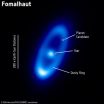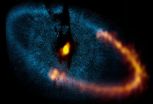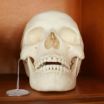(Press-News.org) Astronomers using ESA's Herschel Space Observatory have studied a ring of dust around the nearby star Fomalhaut and have deduced that it is created by the collision of thousands of comets every day.
Fomalhaut, a star twice as massive as our Sun and around 25 light years away, has been of keen interest to astronomers for many years. With an age of only a few hundred million years it is a fairly young star, and in the 1980s was shown to be surrounded by relatively large amounts of dust by the IRAS infrared satellite. Now Herschel, with its unprecedented resolution, has produced the best ever far-infrared images of the system. The star itself is surrounded by hot gas and dust, and there is a warm, dusty disc surrounding it as well. But the most interesting feature is a belt of dusty material on the outer edges of the system.
The belt of dust is relatively far from the star itself, at more than 100 times the distance of the Earth from the Sun. This makes it very cold, at around -200 Celsius, with around half of it being made of water ice. "This disc is similar to the Kuiper Belt in our Solar System, which lies beyond the planet Neptune, but is much, much younger," explained Dr Bruce Sibthorpe, of the UK Astronomy Technology Centre. "As well as relatively large objects, such as Pluto, our Kuiper Belt also contains millions of much smaller objects."
The dusty belt around Fomalhaut is confined into a fairly narrow ring and is also off-centre relative to the star, both of which imply that there could be planets orbiting close to it. In 2008 the Hubble Space Telescope provided possible evidence for a planet orbiting within it – though that has yet to be confirmed.
The way that the dust absorbs, emits and scatters the starlight can be used to deduce the size of the grains. The infrared observations with Herschel have found that the dust absorbs light as if it were made of very small grains, just a few thousandths of a millimetre across. Meanwhile the Hubble Space Telescope images indicate that it scatters light in the same way as much larger particles. These two properties are satisfied if the dust grains are "fluffy", being made of small particles loosely stuck together to make larger ones.
A significant problem with such fluffy grains is that the smaller ones should be blown out of the system by the intense light from Fomalhaut itself. The fact that they are present implies that there is a continuous supply of small particles, most likely produced by the continual collisions and disintegration of larger asteroid-sized objects. Such a ring would contain many icy comets, but to produce the amount of dust seen by Herschel requires the equivalent of around 2000 1km sized comets to be destroyed every day.
"I was really surprised," says Dr Bram Acke, at the University of Leuven, Belgium, who led this study. "To me this was an extremely large number." Such a large number of collisions implies that there are trillions of comets in the ring in total, containing enough material to make over one hundred Earths.
"Herschel is the only facility with the capability to study the small dust grains in such high detail, and thereby provide important insights into the on-going activity within the Fomalhaut disc," says Dr Sibthorpe. "These studies are showing us a young Extra-Solar System in unprecedented detail."
INFORMATION:
Images
The star Fomalhaut and the belt of dust surrounding it, as seen in the far-infrared by the Herschel Space Observatory. The ring of dust is created by the collision of thousands of comets every day. Image credit: ESA/PACS/DEBRIS consortium
Notes for editors
This research is published online: "Herschel Images of Fomalhaut – An extrasolar Kuiper Belt at the height of its dynamical activity," by B. Acke et al (2012) Astronomy & Astrophysics, 540, A125 DOI: 10.1051/0004-6361/201118581
Herschel
Herschel is an ESA space observatory with science instruments provided by European-led Principal Investigator consortia and with important participation from NASA. It was launched in May 2009. This work uses the SPIRE and PACS instruments.
SPIRE
The SPIRE instrument contains an imaging photometer (camera) and an imaging spectrometer. The camera operates in three wavelength bands centred on 250, 350 and 500 μm, and so can make images of the sky simultaneously in three sub-millimetre colours. The SPIRE instrument has been built, assembled and tested in the UK at The Rutherford Appleton Laboratory in Oxfordshire by an international consortium from Europe, US, Canada and China, with strong support from the Science and Technology Facilities Council.
SPIRE has been developed by a consortium of institutes led by Cardiff Univ. (UK) and including: Univ. Lethbridge (Canada); NAOC (China); CEA, LAM (France); IFSI, Univ. Padua (Italy); IAC (Spain); Stockholm Observatory (Sweden); Imperial College London, RAL, UCL-MSSL, UKATC, Univ. Sussex (UK); and Caltech, JPL, NHSC, Univ. Colorado (USA). This development has been supported by national funding agencies: CSA (Canada); NAOC (China); CEA, CNES, CNRS (France); ASI (Italy); MCINN (Spain); SNSB (Sweden); STFC, UKSA (UK); and NASA (USA).
PACS
PACS is also an imaging photometer (camera) and an imaging spectrometer. The camera operates in three bands centred on 70, 100, and 160 μm, respectively. PACS has been developed by a consortium of institutes led by MPE (Germany) and including UVIE (Austria); KUL, CSL, IMEC (Belgium); CEA, OAMP (France); MPIA (Germany); IFSI, OAP/AOT, OAA/CAISMI, LENS, SISSA (Italy); IAC (Spain). This development has been supported by the funding agencies BMVIT (Austria), ESA- PRODEX (Belgium), CEA/CNES (France), DLR (Germany), ASI (Italy), and CICT/MCT (Spain).
UK Space Agency
The UK Space Agency is at the heart of UK efforts to explore and benefit from space. It is responsible for all strategic decisions on the UK civil space programme and provides a clear, single voice for UK space ambitions.
The UK Space Agency is responsible for ensuring that the UK retains and grows a strategic capability in the space-based systems, technologies, science and applications. It leads the UK's civil space programme in order to win sustainable economic growth, secure new scientific knowledge and provide benefits to all citizens.
The UK Space Agency:
Co-ordinates UK civil space activity
Encourages academic research
Supports the UK space industry
Raises the profile of UK space activities at home and abroad
Increases understanding of space science and its practical benefits
Inspires our next generation of UK scientists and engineers
Licences the launch and operation of UK spacecraft
Promotes co-operation and participation in the European Space programme
Contact details
Dr Bruce Sibthorpe
UK Astronomy Technology Centre
Royal Observatory Edinburgh
Email: bruce.sibthorpe@stfc.ac.uk
Tel: +44 (0)7956 619 394
Prof Mike Barlow
Department of Physics and Astronomy
University College London
Email: mjb@star.ucl.ac.uk
Tel: +44 (0)20 7679 7160
Dr Bram Acke
University of Leuven
Email: bram@ster.kuleuven.be
Tel: +32 (0)16 327 939
Dr Chris North
UK Herschel Outreach Officer
School of Physics and Astronomy
Cardiff University
Email: chris.north@astro.cf.ac.uk
Tel: +44 (0)2920 870 537
Madeleine Russell
Press Officer
UK Space Agency
Email: madeleine.russell@ukspaceagency.bis.gsi.gov.uk
Tel: +44 (0)1793 418069
Herschel sees dusty disc of crushed comets
2012-04-13
ELSE PRESS RELEASES FROM THIS DATE:
Study resolves debate on human cell shut-down process
2012-04-13
Researchers at the University of Liverpool have resolved the debate over the mechanisms involved in the shut-down process during cell division in the body.
Research findings, published in the journal PNAS, may contribute to future studies on how scientists could manipulate this shut-down process to ensure that viruses and other pathogens do not enter the cells of the body and cause harm.
Previous research has shown that when cells divide, they cannot perform any other task apart from this one. They cannot, for example, take in food and fluids at the same time as ...
Multitasking – not so bad for you after all?
2012-04-13
Our obsession with multiple forms of media is not necessarily all bad news, according to a new study by Kelvin Lui and Alan Wong from The Chinese University of Hong Kong. Their work shows that those who frequently use different types of media at the same time appear to be better at integrating information from multiple senses - vision and hearing in this instance - when asked to perform a specific task. This may be due to their experience of spreading their attention to different sources of information while media multitasking. Their study is published online in Springer's ...
New advances in the understanding of cancer progression
2012-04-13
Researchers at the Hospital de Mar Research Institute (IMIM) have discovered that the protein LOXL2 has a function within the cell nucleus thus far unknown. They have also described a new chemical reaction of this protein on histone H3 that would be involved in gene silencing, one of which would be involved in the progression of breast, larynx, lung and skin tumours.
Led by Dr Sandra Peiró and published in Molecular Cell journal, the study is a significant advance in describing the evolution of tumours and opens the door to researching new treatments that block their ...
Genetic adaptation of fat metabolism key to development of human brain
2012-04-13
About 300 000 years ago humans adapted genetically to be able to produce larger amounts of Omega-3 and Omega-6 fatty acids. This adaptation may have been crucial to the development of the unique brain capacity in modern humans. In today's life situation, this genetic adaptation contributes instead to a higher risk of developing disorders like cardiovascular disease.
The human nervous system and brain contain large amounts of polyunsaturated fatty acids, and these are essential for the development and function of the brain. These Omega-3 and Omega-6 fatty acids occur ...
Stem cells 'by default'
2012-04-13
Casanova's notion is that stem cells emerge not because of the presence of factors that confer capacity to the stem cell but because of factors that repress the cellular signals for differentiation and specialization. Casanova believes that somehow all non-differentiated cells intrinsically carry the qualities of the stem cell by default and that there are factors at work that remove these capacities. Said another way: a stem cell is a stem cell because it has evaded differentiation. According to Casanova, if the idea of "a stem cell by default" is considered, research ...
Gulf Coast residents say BP Oil Spill changed their environmental views, UNH research finds
2012-04-13
DURHAM, N.H. -- University of New Hampshire researchers have found that residents of Louisiana and Florida most acutely and directly affected by the BP Deepwater Horizon disaster -- the largest marine oil spill in U.S. history -- said they have changed their views on other environmental issues as a result of the spill.
"If disasters teach any lessons, then experience with the Gulf oil spill might be expected to alter opinions about the need for environmental protection. About one-fourth of our respondents said that as a result of the spill, their views on other environmental ...
Biomarker family found for chemo resistant breast cancers
2012-04-13
Biomarkers which could help to predict resistance to chemotherapy in breast cancer patients have been identified by researchers from the University of Hull, UK.
The researchers found a family of proteins to be twice as prevalent in clinical samples obtained from breast cancer patients who were resistant to chemotherapy than those who were successfully treated.
Chemotherapy resistance is a major problem for some types of breast cancer and many patients undergo treatment that does not work, delaying other more suitable treatments and subjecting the patient to adverse ...
ALMA reveals workings of nearby planetary system
2012-04-13
The discovery was made possible by exceptionally sharp ALMA images of a disc, or ring, of dust orbiting Fomalhaut, which lies about 25 light-years from Earth. It helps resolve a controversy among earlier observers of the system. The ALMA images show that both the inner and outer edges of the thin, dusty disc have very sharp edges. That fact, combined with computer simulations, led the scientists to conclude that the dust particles in the disc are kept within the disc by the gravitational effect of two planets — one closer to the star than the disc and one more distant [1].
Their ...
BMC study shows diverting passengers to elevators could help reduce falls at Logan Airport
2012-04-13
(Boston) – A first of its kind study conducted by researchers at Boston Medical Center (BMC)'s Injury Prevention Center (IPC) found that one fall requiring first responder emergency medical services response occurs, on average, approximately every 56 hours at Boston Logan International Airport, with 37 percent of those incidents involving transport to a hospital. The study, which was done at the request of the Massachusetts Port Authority and Massport Fire/Rescue, concludes that diverting at-risk passengers from escalators to elevators could significantly reduce the number ...
Study finds significant skull differences between closely linked groups
2012-04-13
In order to accurately identify skulls as male or female, forensic anthropologists need to have a good understanding of how the characteristics of male and female skulls differ between populations. A new study from North Carolina State University shows that these differences can be significant, even between populations that are geographically close to one another.
The researchers looked at the skulls of 27 women and 28 men who died in Lisbon, Portugal, between 1880 and 1975. They also evaluated the skulls of 40 women and 39 men who died between 1895 and 1903 in the rural ...



